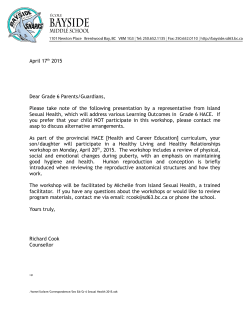
RPE - National Alliance to End Sexual Violence
Rape Prevention & Education Program (RPE) Funding authorized: $50 million FY 15 Appropriation: $38.8 million FY 16 President’s Budget: $44.4 million ($38.8 million for RPE & $5.6 million for evaluation) FY 16 Request: $50 million ($44.4 million for the RPE Program & $5.6 million for evaluation) RPE formula grants, administered by the CDC Injury Center, provide essential funding to states and territories to support rape prevention and education programs conducted by rape crisis centers, state sexual assault coalitions, and other public and private nonprofit entities. Based on 2012 CDC data of RPE funded programs: 110,996 professionals were trained in sexual violence issues Over 1.5 million young people participated in rape prevention programs including: o 469,525 elementary school students; o 523,133 middle school students; o 545,845 high school students; and o 176,360 college students. RPE funded hotlines in 16 states including responses to 178,974 calls. Those who have been victimized by sexual violence are more likely to be re-victimized AND those who have perpetrated are more likely to reoffend, pointing to the increased need to stop the violence before it ever happens. If our children are to face a future free from sexual violence, RPE must be fully funded. The RPE program prepares everyday people to become heroes, getting involved in the fight against sexual violence and creating safer communities by: Engaging boys and men as partners; Supporting multidisciplinary research collaborations; Fostering cross-cultural approaches to prevention; and Promoting healthy, non-violent social norms, attitudes, beliefs, policies, and practices. RPE is working. Building on the success of the innovative Green Dot bystander intervention campaign on campuses, Kentucky RPE programs are expanding into high schools. In an evaluation done with 7,900 undergraduates, students trained in Green Dot had lower rape myth acceptance scores and engaged in significantly more bystander behaviors such as speaking up when they see a friend who is being sexually harassed or finding a trusted adult who can support in intervening when they witness acts of violence. Across the country, states and communities are engaged in cutting-edge prevention projects: Iowa: The University of Northern Iowa developed a certification program to equip graduates to lead bystander intervention programming in their work with youth. Kansas: Thirteen schools in Kansas are starting the third year of implementation and evaluation of the Committee for Children's Steps to Respect (STR) Program. The schools are using the results to prevent bullying behavior, improve school climate, and to make continuing improvements to the program itself. Massachusetts: The Working Group on Campus Sexual Violence held summits at Brandeis University and the University of Massachusetts Amherst to address prevention on campus. Minnesota: Ramsey County Commissioner Jim McDonough worked with RPE staff to educate 100 county leaders and managers about sexual violence as part of his goal to fully mobilize his community to engage in prevention and challenged other counties to do the same: "I want talking about sexual violence to become as easy as talking about hockey." - Commissioner Jim McDonough Why increase funding for RPE? The societal costs of sexual violence are incredibly high including medical and mental health care, law enforcement response, and lost productivity. Annual victim costs for rape are estimated at $127 billion making rape the most costly of all crimes. According to the National Intimate Partner and Sexual Violence Survey (CDC, 2011): Nearly 1 in 5 women have been the victim of rape or attempted rape. Most female victims of completed rape (79.6%) experienced their first rape before the age of 25; 42.2% experienced their first completed rape before the age of 18 years. More than one-quarter of male victims of completed rape (27.8%) experienced their first rape when they were 10 years of age or younger. The national focus on campus and military sexual assault as well as high profile cases of sexual violence in the media have increased the need for comprehensive community responses to sexual violence but has also increased the demand for prevention programs beyond providers’ capacity. A 2014 survey by the NAESV revealed that over 1/4 of rape crisis centers had to decrease the number of prevention education services due to insufficient funding while almost 20% of programs could not provide services within one month of a request. Additionally, VAWA 2013 changed the formula for RPE ensuring that small states have a base of $150,000 but meaning large states are experiencing a significant cut since FY 2014. NAESV urges increased program funding to $44.4 million to respond to the shortfall. An Illinois program reported: “..demands for prevention programming have increased dramatically. We have been able to schedule with some schools that we had never worked with before but most opportunities are for 1 shot programming to a very large group. In our experience, repeat or ongoing programming that builds on skills is most effective …With limited staff, this type of programming is not available.” A California program reported: “We can no longer do prevention at many schools that know and love our classes. The students are not getting information on healthy relationships and anti-dating violence.” A Pennsylvania program reported: “Our Education/Prevention Services Department is over booked and over loaded with requests from schools, community groups and other social services agencies for programs, mandated reporting training and other valuable resources we offer for the education and prevention of sexual assault …” Evaluating RPE It is vitally important to continue to strengthen the evidence base for sexual violence prevention. The RPE program was created to develop culturally relevant community-based sexual assault prevention strategies across the nation. RPE program funding must remain in communities while new funds are invested for evaluation. NAESV supports the President’s request in the FY 2016 budget of additional and separate funding for evaluation. HAVE ADDITIONAL QUESTIONS? Contact Terri Poore at terri@endsexualviolence.org
© Copyright 2025











